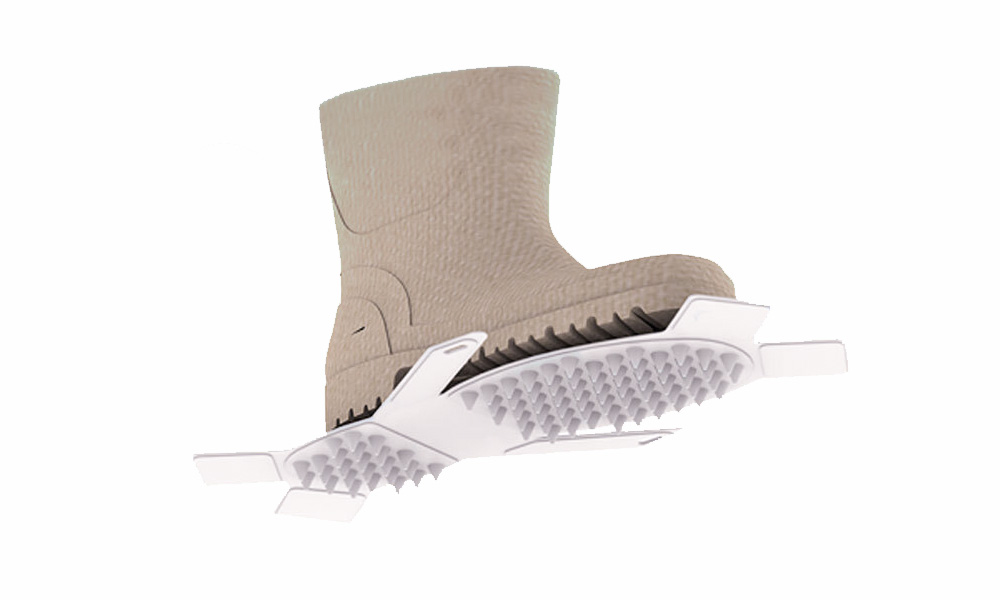Join the United States Armed Forces (any branch) and part of the provided uniform is one pair of standard-issue combat boots. Designed for dry conditions, the boots’ composite rubber soles provide adequate footing for walking on concrete, asphalt, and packed dirt, but not so much when the terrain is covered in mud, slush, snow, or ice. In slippery conditions, soldiers, marines, and national guardsmen use paracord to strap on spiked cleats for improved traction.
This concept saves space, weight, and cost as it eliminates the need to outfit every soldier facing extreme weather conditions with a second pair of boots. Rather, they slip a pair of thin lightweight cleats into a backpack and attach/detach them as needed. Though these spiked cleats are an excellent idea, creating them requires weeks of manufacturing lead time and uses costly production methods. These are unacceptable variables when dealing with short deployment windows and weather-related emergencies. Essentium believed these issues could be resolved with additive manufacturing (AM).
3D printed accessories can be precisely fitted for use on or over standard-issue military equipment to improve performance, extend life, and expand the capabilities of existing gear — in this case transforming ordinary combat boots into extreme weather snow boots.
Don’t reinvent the military boot, reinvent the accessory
Snow cleats, as they are often called, are traditionally made using several different materials and processes; a flexible base that straps to the underside of the boot is attached to a chain or wire mesh embedded with metal spikes for traction. Injection-molded parts must be created for every size boot in inventory — an expensive and lengthy process. Metal spikes must be cut and machined, and the parts are then assembled manually.
AM is an excellent alternative for this application as it reduces the number of technologies, machines, and materials to one, eliminating sub-assembly tasks and the need to inventory multiple parts, tools, and raw materials.
Mimicking the design of the Army’s most effective snow cleat, Leslie Bush, Essentium Applications Engineer, was able to quickly progress through the CAD-assisted software prototype and iteration process, experimenting with various spike geometries, patterns, and filaments to yield a workable model optimized for AM in just a few days.
The traction cleats are 3D printed upside-down in one piece, creating the flat base and boot attachment flaps first before building a precisely spaced pattern of raised spikes (Figure B). No assembly is required other than threading paracord for attachment to the boot.
The design was kept as slim as possible, approximately ½” in height, to occupy minimal backpack space. Essentium TPU-74D, a flexible, lightweight, yet high-performance filament, was selected for the material as it provides superior wear and tear resistance with performance equal to metal-spiked snow cleats. A one-piece solution, the Essentium cleat packs more spikes into the design for better traction yet retains the flexibility for the flaps to wrap snugly around the boot (Figure C).
Once the 3D design was finalized, the software easily scaled the cleat up or down proportionally to print one-piece traction cleats matching the exact sole size in the quantities needed — no molds required. In the event of a lost or broken cleat, a new one can be printed on-demand at the point of need for only the cost of filament; no minimum quantity order, no logistics headaches from waiting for third-party suppliers to deliver.
Turnaround is further improved as the large build area of the Essentium HSE 3D Printing Platform enables production at scale. Up to six pairs of cleats can be printed as a single job in just a few hours. Equipping an entire platoon or company with 3D printed traction cleats can be accomplished in a matter of days — perfect for situations with short deployment windows.
3D printed traction cleats are just one example of how AM can maximize the investment in other equipment and technologies, cut links out of supply chains, and return control over design, deadlines, and cost to front-line users.
www.essentium.com
